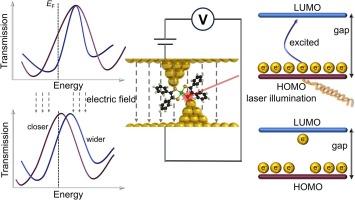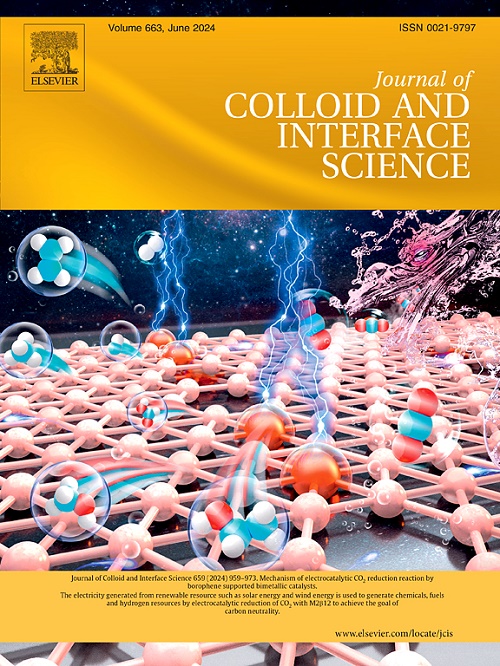具有强分子-电极耦合的超高导电性光电调制单分子双(二硫环戊烯)镍结
IF 9.4
1区 化学
Q1 CHEMISTRY, PHYSICAL
引用次数: 0
摘要
单分子结中的金与脱局域分子线之间的轨道杂化产生的强分子-电极耦合促进了智能分子设备的便捷传输。在本文中,我们利用扫描隧道显微镜断点技术,报告了基于高度去局域化的双(二硫环戊烯)镍(NiS4)分子结的超高导电单分子电路。对这两种 NiS4 的单分子电荷传输测量显示,它们分别表现出 10-1.49 G0 和 10-1.51 G0 的高电导率。此外,在高偏置电压的干预下,分子电导率可进一步提高到约 10-1.00 G0,这是迄今为止在类似分子长度条件下报告的最高值。理论计算表明,这两个结中的π通道和金电极之间存在着强烈的杂化作用,而且这种杂化作用从分子-电极界面进一步延伸到金属电极,这一点从透射特征状态的等值面图中可以看出,这不仅导致占主导地位的 LUMO 峰向费米级发生明显的能量移动,而且还导致透射函数中的 LUMO 共振出现宽阔的峰值。此外,在共振光激发下,这两个分子结都显示出显著的光电导性,约为 10-1.00 G0,这是由于这些分子结中可能存在激子结合。有趣的是,这两个分子结在光电调制下的电导切换是高度可逆的,从而形成了一个多刺激响应分子开关。这项工作不仅为制造具有强分子-电极耦合的高导电分子线提供了构件,还为设计光电调制功能分子级器件奠定了基础。本文章由计算机程序翻译,如有差异,请以英文原文为准。

Ultra-highly conductive optoelectronic modulated single-molecule nickel bis(dithiolene) junctions with strong molecule-electrode coupling
Strong molecule-electrode coupling originating from orbit hybridization between gold and the delocalized molecular wires in single-molecule junctions facilitates facile transport towards smart molecular devices. In this paper, we report ultra-highly conductive single-molecule circuits based on highly delocalized nickel bis(dithiolene) (NiS4) molecular junctions using scanning tunneling microscope break junction technique. Single-molecule charge transport measurement of both NiS4 reveals they exhibits high conductance of 10−1.49 G0 and 10−1.51 G0, respectively. Moreover, under intervention of high bias voltage the molecular conductance could be further improved to approximately 10−1.00 G0, the highest value reported to date with similar molecular lengths. Theoretical calculations suggest that the strong hybridization of the π-channels and the gold electrodes in both junctions exists and it further extends from molecule-electrode interfaces to metal electrodes as visualized by the isosurface plots of the transmitting eigenstate, which lead to not only a distinct energy shift of the dominated LUMO peaks toward Fermi level, but also broad peaks in the LUMO resonance in the transmission functions. In addition, the both molecular junctions show remarkable photoconductance of approximately 10−1.00 G0 under resonant light excitation, due to possible exciton binding in these junctions. Interestingly, the conductance switching of both molecular junctions under optoelectronic modulation is highly reversible, forming a multi-stimulus responsive molecular switch. This work not only provides a building block for fabricating highly conducting molecular wires with strong molecule-electrode coupling, but also lays a foundation for designing optoelectronic modulated functional molecule-scale devices.
求助全文
通过发布文献求助,成功后即可免费获取论文全文。
去求助
来源期刊
CiteScore
16.10
自引率
7.10%
发文量
2568
审稿时长
2 months
期刊介绍:
The Journal of Colloid and Interface Science publishes original research findings on the fundamental principles of colloid and interface science, as well as innovative applications in various fields. The criteria for publication include impact, quality, novelty, and originality.
Emphasis:
The journal emphasizes fundamental scientific innovation within the following categories:
A.Colloidal Materials and Nanomaterials
B.Soft Colloidal and Self-Assembly Systems
C.Adsorption, Catalysis, and Electrochemistry
D.Interfacial Processes, Capillarity, and Wetting
E.Biomaterials and Nanomedicine
F.Energy Conversion and Storage, and Environmental Technologies

 求助内容:
求助内容: 应助结果提醒方式:
应助结果提醒方式:


